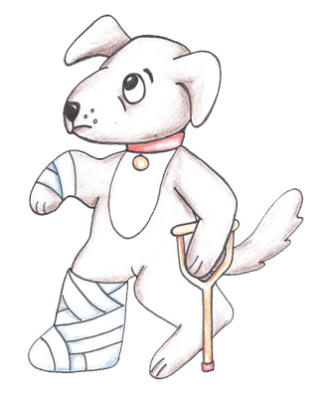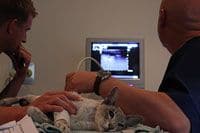Broken Legs Or Penetrating Wounds
What to do if your pet has a fracture or a bleeding wound

Emergency Treatment
Fractures: – Is the skin broken or intact? Broken skin needs to be covered with a clean towel or cloth to prevent further contamination and help to stop active bleeding. Place your pet in a cage, washing basket or on a board to prevent the limb from dangling or being moved. Although splinting is possible, it will often cause more trauma to your pet (and possibly yourself when you are bitten) so it is best avoided unless you have a long trip ahead of you. Instead, make sure your pet is in a comfortable position to minimize movement.
Penetrating wound (e.g. stick, stake) – Leave the object in place if possible. The object maybe preventing further bleeding and removing it without medical care immediately available can lead to excessive blood loss. Incorrect removal can also cause additional damage.
Bleeding wound – Place a clean towel, cloth or feminine pad over the site and place pressure to slow the bleeding.
Fractures, penetrating wounds and bleeding wounds need to be seen as soon as possible to give your pet the best possible chance for successful treatment, and to reduce further complications – seek veterinary attention immediately.
What to expect at the vet
- Intravenous fluid therapy – to treat shock from bleeding or other causes
- Pain relief – fractures and wounds are painful and need to be managed immediately
- Radiographs (x-rays) – to assess the extent of the injuries
- If a penetrating wound – your pet may need to be anaesthetised for the wound to be cleaned and possibly sutured (stitched up), depending on how dirty it appears when presented
- If bleeding – it will need to be stopped and assessed by your vet before deciding on the next course of action
- Bandaging – to stop the limb from moving
- Surgery – most wounds or fractures require some type of minor or major surgery. Post surgical management once your pet is home may require cage rest and physiotherapy for 6 to 8 weeks
With appropriate and timely treatment, most traumatic injuries can be managed with a successful outcome for your pet.
Trauma Advice | Head Injuries | Transporting Pets With Injuries | Pet Seizures



